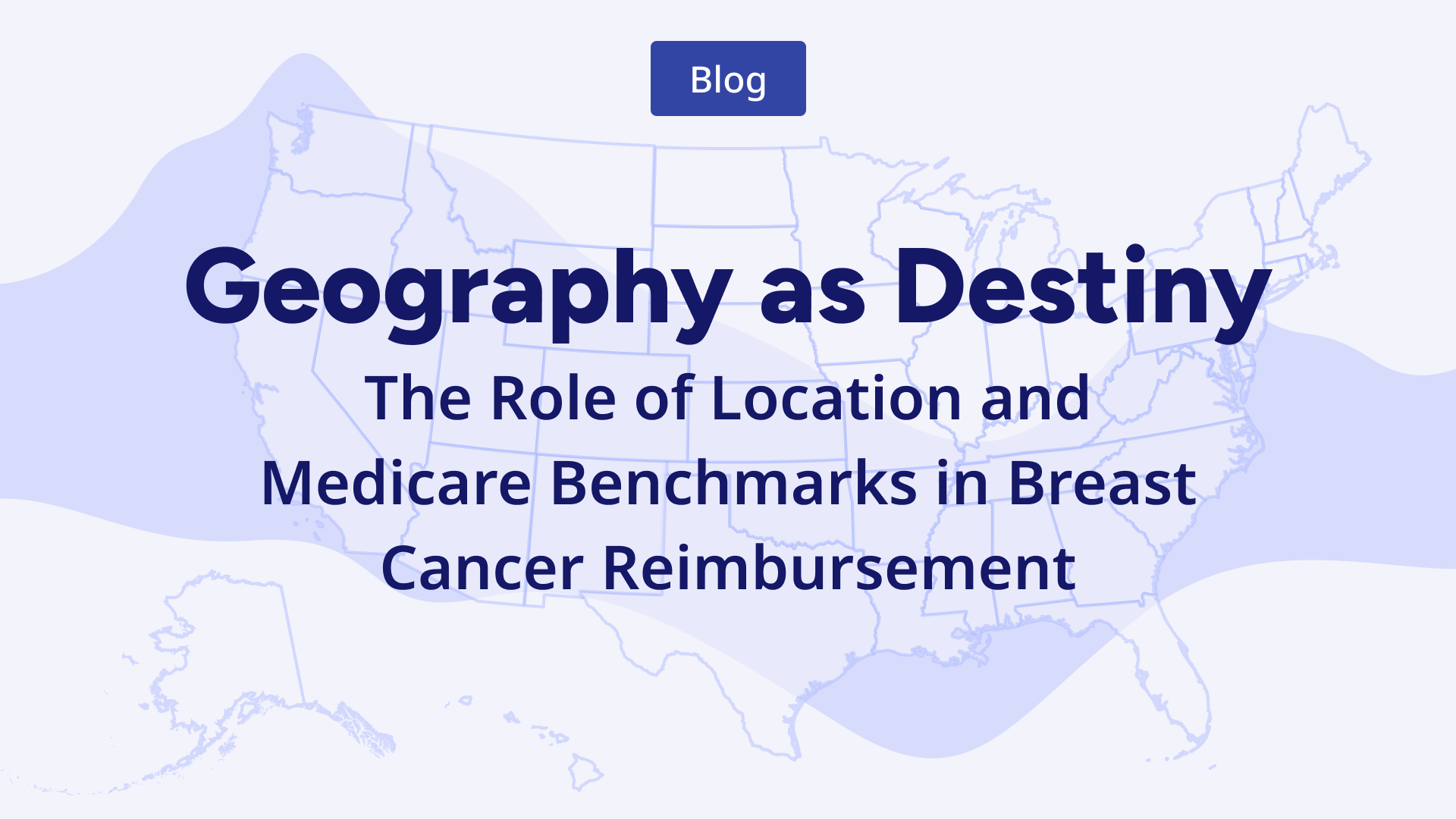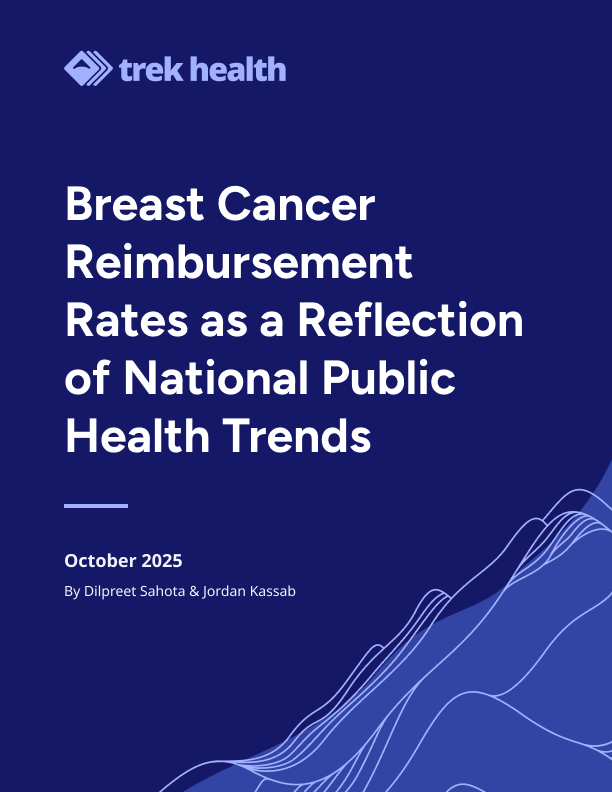
Geography as Destiny: The Role of Location and Medicare Benchmarks in Breast Cancer Reimbursement
Introduction
Geography affects nearly all aspects of U.S. healthcare: resources, expenses, lifestyle, and disease trends. These differences are highlighted when analyzing breast cancer reimbursement: where a patient lives explains nearly half of the variation in payments, even more than payer strategy itself. These disparities are further exacerbated by adding state-specific Medicare benchmarks into the mix.
State By State, Wide Gaps
Our analysis found that state alone explained roughly 50% of the variation in breast cancer reimbursement. That means geography is one of the strongest predictors of what providers are paid. Ignoring other variables, location itself becomes the single most powerful factor in determining rates, independent of patient complexity, provider supply, or policy design. At the extremes, Alaska had the highest average reimbursement, whereas Arizona had the lowest, a difference of hundreds of dollars for the same exact service that cannot be explained by clinical practice alone.
Payer Patterns Within States
Looking at individual commercial payers, we found striking differences in how reimbursement is distributed. Aetna exhibited the widest state-level variation, with payments fluctuating significantly across markets and averaging below the national mean. Cigna, by contrast, showed the narrowest spread, but were consistently priced above the mean. These patterns suggest that payer strategy itself compounds on the existing geographic differences. Some insurers adjust rates widely, while others stick to more narrow windows for all of their contracts. For providers, this means that negotiating power can look very different depending on which payer dominates the local market. Even within a single state, two systems contracting with different payers may face very different revenues for the same service.

The Medicare Baseline
To ground these findings, we compared commercial reimbursement against Medicare rates. As expected, Medicare pays less than commercial insurers across the board, but it offers a uniform national benchmark against which differences become visible. What emerged was striking variation in the size of those gaps. Wisconsin showed the largest gap, with commercial rates exceeding Medicare by an average of $967. Texas, on the other hand, had the slimmest gap, being just $67.
These outliers highlight how federal benchmarks and local markets can interact in unexpected ways. In Wisconsin, commercial payers stretch far above Medicare, delivering providers some of the nation’s largest margins. In Texas, the picture is reversed: an unusually high Medicare baseline paired with one of the lowest commercial reimbursement levels leaves providers operating on razor-thin margins. These disparities highlight how Medicare functions as both a stabilizing anchor and a mirror for inequities in the commercial market.
The Inequity of Geography
Taken together, the data shows that geography is dominant in determining breast cancer reimbursement. Two patients in different states can receive the same service but generate dramatically different reimbursement, and commercial contracts amplify this gap even further. While health inequities are frequently discussed through the lens of social determinants of health, those conversations typically focus on outcomes such as mortality or screening rates. What our analysis highlights is inequity in the financial foundation of care itself: the rates providers are reimbursed.
For providers, reimbursement levels directly affect sustainability. Lower payments constrain the ability to invest in staff, technology, and preventive programs, while higher payments create more financial flexibility. In markets where reimbursement lags, practices may be forced to consolidate, reduce service lines, or limit patient intake, all of which ripple into access. For patients, they translate into uneven access and investment depending on where they live.
Trek Health’s Perspective
By benchmarking commercial rates against both state peers and Medicare standards, our platform empowers health systems to identify inequities and negotiate from strength. Geography may set the baseline, but unlocking this data can empower the payer renegotiations with data-back evidence. Breast cancer reimbursement in the U.S. is seemingly less about evidence-based care and more about ZIP codes and benchmarks. State explains half the variation, and commercial payers diverge significantly from Medicare in ways that amplify inequity. Trek Health helps providers uncover these gaps and advocate for fairer, more equitable contracts, so that outcomes aren’t dictated by geography.

White Paper
From Transparency to Prediction: Quantifying the Drivers of Physician Reimbursement Variation
This analysis uses Transparency in Coverage data to model how payers behave, not just what they pay. By linking reimbursement rates to physician characteristics, we uncover the patterns behind payment variation and transform transparency data into predictive intelligence. The result: a predictive view of rate dynamics that helps stakeholders anticipate trends and negotiate with data-driven confidence.

White Paper
Q3 2025 State of Commercial Reimbursement: Trek Health’s Quarterly Market Intelligence
Trek Health’s Quarterly Reimbursement Brief highlights emerging variability in commercial payment rates across U.S. payers, specialties, and geographic markets. With some segments experiencing double-digit growth and others notable declines, contracting performance is increasingly shaped by real-time payer behavior rather than historical norms. Through validated reimbursement trend analytics, contract intelligence, and policy monitoring, Trek equips provider organizations to anticipate market shifts, protect revenue, and negotiate with measurable leverage.

White Paper
Reimbursement and Reality: The Economics of Breast Cancer Treatment
While breast cancer awareness efforts often focus on screening and treatment, one critical factor remains overlooked: how care is reimbursed. Payment structures shape far more than provider margins; they influence access, equity, and patient outcomes.
In this analysis of payer rates, Trek Health uses its Transparency Platform to analyze how reimbursement for breast cancer care varies across geography, commercial payer behavior, and public policy. The findings reveal a system that rewards disease burden rather than prevention which creates inequities that ripple through the entire care process.
Inside you’ll learn:
- How reimbursement rates differ dramatically by state and payer
- Why higher disease burden correlates with higher payment, but prevention does not
- What these trends mean for provider strategy, patient access, and equity
Download the full analysis to see how transparency data can help reshape breast cancer care—turning financial insight into fairer outcomes.

White Paper
The Private Practice Playbook: Rate Negotiation Index Rankings for Specialty-Specific M&A Strategy
Physician economics are shifting as private equity and independent platforms redefine the workforce landscape. Trek Health’s Rate Negotiation Index Report quantifies the return on physician labor across states and specialties in a new lens: combining commercial reimbursement, physician salary, malpractice risk, and provider density into a single metric. This data driven foundation for smarter M&A strategy identifies the most economically sustainable opportunities across the U.S. for physician recruitment and network expansion.

Introduction
Geography affects nearly all aspects of U.S. healthcare: resources, expenses, lifestyle, and disease trends. These differences are highlighted when analyzing breast cancer reimbursement: where a patient lives explains nearly half of the variation in payments, even more than payer strategy itself. These disparities are further exacerbated by adding state-specific Medicare benchmarks into the mix.
State By State, Wide Gaps
Our analysis found that state alone explained roughly 50% of the variation in breast cancer reimbursement. That means geography is one of the strongest predictors of what providers are paid. Ignoring other variables, location itself becomes the single most powerful factor in determining rates, independent of patient complexity, provider supply, or policy design. At the extremes, Alaska had the highest average reimbursement, whereas Arizona had the lowest, a difference of hundreds of dollars for the same exact service that cannot be explained by clinical practice alone.
Payer Patterns Within States
Looking at individual commercial payers, we found striking differences in how reimbursement is distributed. Aetna exhibited the widest state-level variation, with payments fluctuating significantly across markets and averaging below the national mean. Cigna, by contrast, showed the narrowest spread, but were consistently priced above the mean. These patterns suggest that payer strategy itself compounds on the existing geographic differences. Some insurers adjust rates widely, while others stick to more narrow windows for all of their contracts. For providers, this means that negotiating power can look very different depending on which payer dominates the local market. Even within a single state, two systems contracting with different payers may face very different revenues for the same service.

The Medicare Baseline
To ground these findings, we compared commercial reimbursement against Medicare rates. As expected, Medicare pays less than commercial insurers across the board, but it offers a uniform national benchmark against which differences become visible. What emerged was striking variation in the size of those gaps. Wisconsin showed the largest gap, with commercial rates exceeding Medicare by an average of $967. Texas, on the other hand, had the slimmest gap, being just $67.
These outliers highlight how federal benchmarks and local markets can interact in unexpected ways. In Wisconsin, commercial payers stretch far above Medicare, delivering providers some of the nation’s largest margins. In Texas, the picture is reversed: an unusually high Medicare baseline paired with one of the lowest commercial reimbursement levels leaves providers operating on razor-thin margins. These disparities highlight how Medicare functions as both a stabilizing anchor and a mirror for inequities in the commercial market.
The Inequity of Geography
Taken together, the data shows that geography is dominant in determining breast cancer reimbursement. Two patients in different states can receive the same service but generate dramatically different reimbursement, and commercial contracts amplify this gap even further. While health inequities are frequently discussed through the lens of social determinants of health, those conversations typically focus on outcomes such as mortality or screening rates. What our analysis highlights is inequity in the financial foundation of care itself: the rates providers are reimbursed.
For providers, reimbursement levels directly affect sustainability. Lower payments constrain the ability to invest in staff, technology, and preventive programs, while higher payments create more financial flexibility. In markets where reimbursement lags, practices may be forced to consolidate, reduce service lines, or limit patient intake, all of which ripple into access. For patients, they translate into uneven access and investment depending on where they live.
Trek Health’s Perspective
By benchmarking commercial rates against both state peers and Medicare standards, our platform empowers health systems to identify inequities and negotiate from strength. Geography may set the baseline, but unlocking this data can empower the payer renegotiations with data-back evidence. Breast cancer reimbursement in the U.S. is seemingly less about evidence-based care and more about ZIP codes and benchmarks. State explains half the variation, and commercial payers diverge significantly from Medicare in ways that amplify inequity. Trek Health helps providers uncover these gaps and advocate for fairer, more equitable contracts, so that outcomes aren’t dictated by geography.


